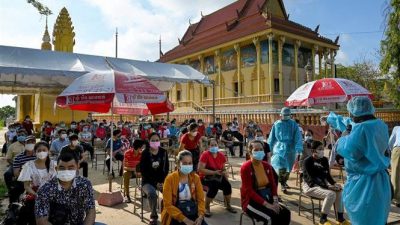
|
Although Japan’s economic outlook is still in a “twilight” state, most Japanese politicians and economists still believe in a bright future for the country’s economy under the leadership of new Prime Minister Suga Yoshihide. |
|
The picture of Japan’s economy has both a dark and bright side as industrial output has recorded an increase for the third consecutive month, but the unemployment rate is still at its highest level for the past three years. Experts forecast that the Japanese economy will recover in the last quarter of the year. A report released by the Japanese Ministry of Economy, Trade and Industry (METI) showed that the country’s industrial output in August rose by 1.7% from the previous month, marking an increase for the third month in a row thanks to an increased demand for cars. This index in July also increased by 8.7% from the previous month. METI said that industrial output in Japan is moving in an upward direction. However, this result is still lower than in March 2020, when the nation’s economy wasn’t as affected by the COVID-19 pandemic. Another bright spot in the picture of the Japanese economy is that the industrial export index in August also increased by 2.1%, up to 87.6 points, while the inventory index decreased by 1.4%, down to 97.9. Production in the auto industry in August increased by 8.9% from the previous month, as some carmakers are starting to produce new car models as demand for cars recovers. However, besides these bright and hopeful highlights, the picture of Japan’s economy still has many dark colours as some markets are remaining bleak. The Japan Automobile Dealers Association (JADA) said on October 1 that car sales in the country during the first half of the 2020-2021 fiscal year (from April to September 2020) decreased by 22.6% YoY, the strongest drop in nine years, to 2.02 million units, due to the heavy impact of the pandemic. JADA said that the COVID-19 epidemic had seriously affected both car production and the number of customers buying cars in the first six months of the fiscal year 2020-2021. In September alone, total car sales in Japan were down 14.3% year-on-year at 469,705 units, marking the 12th consecutive month of decline. Another worrying problem is that Japan’s unemployment rate is now at its highest level in three years. The Ministry of Internal Affairs and Communications on October 2 said that the total unemployed rate in the world’s third largest economy rose in August to 3% for the first time, the highest level since May 2017, with 2.06 million jobs lost. Accordingly, the number of Japanese people in employment in August this year reached 66.76 million, a decrease of 750,000 over the same period in 2019, having also recorded it as the fifth consecutive month of decrease. Japan’s economic growth declined in the first two quarters of this year and many economists predict the economy will gradually recover in the last months of the year, but the economic outlook is still fraught with risks due to the number of Covid-19 infections in many parts of Japan still increasing. In the above context, the Government of Japan is considering an additional large-scale financial stimulus package, especially in terms of job support. According to the secretary-general of Japan’s ruling Liberal Democratic Party (LDP), the country is considering drafting an additional large-scale fiscal stimulus package to cope with the economic impact of the pandemic and the government may put in place a third budget to increase “power” within the economy. So far, Japan has spent 234 trillion yen, or about 40% of its GDP, on two economic stimulus packages ,deployed in response to the impact of the pandemic. Coping with unemployment is also a focus in the fight to both stop the COVID-19 epidemic and revive the economy of the current Government of Japan. The president of the LDP’s policy research council has emphasised that the implementation of additional economic measures is the most important task and one possible measure is to expand the support programme to small businesses and traders. Although the Japanese economic outlook is still in both an gloomy and bright state, most Japanese political circles and economic experts still believe in a bright future for the country’s economy under the direction of new PM Suga Yoshihide. The newly-elected PM is actively realising his campaign commitment to continue the policies of his predecessor Abe Shinzo’s administration as well as considering their response to the COVID-19 pandemic a top priority. Now sitting in the “hot seat” left by Abe, new PM Suga met privately with 20 ministers and sent out a message that the new cabinet would “work for the people.” According to the Japanese press, the new PM has identified 40 priority projects, from defence procurement to digitising Japan’s cumbersome administrative systems. With the above practical actions from “conductor” Suga Yoshihide, Japanese people can trust and hope that their economy will overcome difficulties soon, as Suga himself has expressed his belief that “no matter how harsh the winter is, spring will come and the snow will melt.” Source: Nhan Dan Online |
